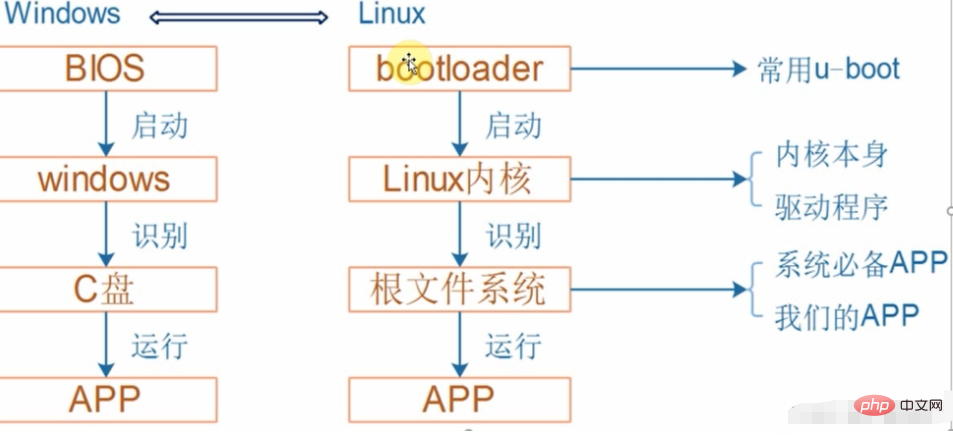What is linux embedded development
Linux embedded development refers to the development of embedded operating systems based on Linux; embedded Linux is characterized by open source code and compliance with the GPL agreement. Embedded Linux refers to the Linux operating system running on embedded devices , equivalent to a complete PC software system.

#The operating environment of this tutorial: linux7.3 system, Dell G3 computer.
What is linux embedded development
Embedded development refers to development under an embedded operating system. Embedded Linux is an embedded operating system based on Linux. Here we provide content related to embedded development, embedded development board information, embedded Linux development knowledge, etc.
Embedded Linux is a new member of the embedded operating system. Its biggest feature is that its source code is open and follows the GPL agreement, which has become a research hotspot. Among the embedded systems being developed, nearly 50% of the projects choose Linux as the embedded operating system.
Embedded linux is an operating system that tailors and modifies the increasingly popular Linux operating system so that it can run on embedded computer systems. Embedded Linux not only inherits the unlimited open source code resources on the Internet, but also has the characteristics of an embedded operating system.
Embedded Linux is characterized by free copyright fees; purchase fees, media costs, technical support, free software developers around the world to provide support, network features, free, excellent performance, easy software transplantation, open code, and many application software Support, application product development cycle is short, new products can be launched quickly, because there are many public codes that can be referenced and transplanted, real-time performance RT_Linux Hardhat Linux and other embedded Linux support, real-time performance is stable and secure.

Embedded: In addition to computers, other devices that can run programs are embedded devices. The so-called embedding is to embed the CPU into a device so that it has the ability to run programs. Capacity, computing power, such as smart watches. All microcontroller developments are embedded devices. Embedded Linux refers to the Linux operating system running on the embedded device, similar to a computer running a Windows system.
The embedded Linux system is equivalent to a complete PC software system. Different from Windows, all parts of Linux software are basically open source. We can find the source code of these software on some open source websites to facilitate learning and development.
Recommended learning: Linux video tutorial
The above is the detailed content of What is linux embedded development. For more information, please follow other related articles on the PHP Chinese website!

Hot AI Tools

Undresser.AI Undress
AI-powered app for creating realistic nude photos

AI Clothes Remover
Online AI tool for removing clothes from photos.

Undress AI Tool
Undress images for free

Clothoff.io
AI clothes remover

Video Face Swap
Swap faces in any video effortlessly with our completely free AI face swap tool!

Hot Article

Hot Tools

Notepad++7.3.1
Easy-to-use and free code editor

SublimeText3 Chinese version
Chinese version, very easy to use

Zend Studio 13.0.1
Powerful PHP integrated development environment

Dreamweaver CS6
Visual web development tools

SublimeText3 Mac version
God-level code editing software (SublimeText3)

Hot Topics
 What computer configuration is required for vscode
Apr 15, 2025 pm 09:48 PM
What computer configuration is required for vscode
Apr 15, 2025 pm 09:48 PM
VS Code system requirements: Operating system: Windows 10 and above, macOS 10.12 and above, Linux distribution processor: minimum 1.6 GHz, recommended 2.0 GHz and above memory: minimum 512 MB, recommended 4 GB and above storage space: minimum 250 MB, recommended 1 GB and above other requirements: stable network connection, Xorg/Wayland (Linux)
 vscode cannot install extension
Apr 15, 2025 pm 07:18 PM
vscode cannot install extension
Apr 15, 2025 pm 07:18 PM
The reasons for the installation of VS Code extensions may be: network instability, insufficient permissions, system compatibility issues, VS Code version is too old, antivirus software or firewall interference. By checking network connections, permissions, log files, updating VS Code, disabling security software, and restarting VS Code or computers, you can gradually troubleshoot and resolve issues.
 How to run java code in notepad
Apr 16, 2025 pm 07:39 PM
How to run java code in notepad
Apr 16, 2025 pm 07:39 PM
Although Notepad cannot run Java code directly, it can be achieved by using other tools: using the command line compiler (javac) to generate a bytecode file (filename.class). Use the Java interpreter (java) to interpret bytecode, execute the code, and output the result.
 Linux Architecture: Unveiling the 5 Basic Components
Apr 20, 2025 am 12:04 AM
Linux Architecture: Unveiling the 5 Basic Components
Apr 20, 2025 am 12:04 AM
The five basic components of the Linux system are: 1. Kernel, 2. System library, 3. System utilities, 4. Graphical user interface, 5. Applications. The kernel manages hardware resources, the system library provides precompiled functions, system utilities are used for system management, the GUI provides visual interaction, and applications use these components to implement functions.
 How to use VSCode
Apr 15, 2025 pm 11:21 PM
How to use VSCode
Apr 15, 2025 pm 11:21 PM
Visual Studio Code (VSCode) is a cross-platform, open source and free code editor developed by Microsoft. It is known for its lightweight, scalability and support for a wide range of programming languages. To install VSCode, please visit the official website to download and run the installer. When using VSCode, you can create new projects, edit code, debug code, navigate projects, expand VSCode, and manage settings. VSCode is available for Windows, macOS, and Linux, supports multiple programming languages and provides various extensions through Marketplace. Its advantages include lightweight, scalability, extensive language support, rich features and version
 Can vscode be used for mac
Apr 15, 2025 pm 07:36 PM
Can vscode be used for mac
Apr 15, 2025 pm 07:36 PM
VS Code is available on Mac. It has powerful extensions, Git integration, terminal and debugger, and also offers a wealth of setup options. However, for particularly large projects or highly professional development, VS Code may have performance or functional limitations.
 How to check the warehouse address of git
Apr 17, 2025 pm 01:54 PM
How to check the warehouse address of git
Apr 17, 2025 pm 01:54 PM
To view the Git repository address, perform the following steps: 1. Open the command line and navigate to the repository directory; 2. Run the "git remote -v" command; 3. View the repository name in the output and its corresponding address.
 What is vscode What is vscode for?
Apr 15, 2025 pm 06:45 PM
What is vscode What is vscode for?
Apr 15, 2025 pm 06:45 PM
VS Code is the full name Visual Studio Code, which is a free and open source cross-platform code editor and development environment developed by Microsoft. It supports a wide range of programming languages and provides syntax highlighting, code automatic completion, code snippets and smart prompts to improve development efficiency. Through a rich extension ecosystem, users can add extensions to specific needs and languages, such as debuggers, code formatting tools, and Git integrations. VS Code also includes an intuitive debugger that helps quickly find and resolve bugs in your code.






